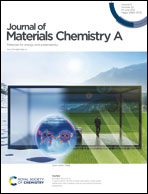A tuned Lewis acidic catalyst guided by hard–soft acid–base theory to promote N2 electroreduction†
Abstract
The electrocatalytic N2 reduction reaction (NRR) to ammonia (NH3) driven by intermittent renewable electricity under ambient conditions offers an alternative to the energy-intensive Haber–Bosch process. However, as a distinct core of the process, the design strategy of the electrocatalyst for enhancing the N2 activation ability is still in a trial-and-error stage due to the absence of theoretical guidance. As a result, the corresponding NH3 yield rate and selectivity are much lower than that required for implementation at scale. In this work, on the basis of the hard–soft acid–base theory, we report a paradigm for the design of an electrocatalyst with tuned Lewis acidity to efficiently activate and reduce N2 to NH3. As a proof of concept, it is revealed that enhancing the Lewis acidity of the molybdenum sulfide (MoSx) model catalyst supported on carbon nanotubes can greatly improve its activation ability toward the N2 molecule. Accordingly, a high faradaic efficiency of 21.60 ± 2.35% and NH3 yield rate of 40.4 ± 3.6 μg h−1 mgcat.−1 are obtained over the modified MoSx, which are ∼2 times enhanced in comparison with the original MoSx, respectively. Density functional theory calculations verify that the electron transfer from the occupied σ orbitals of N2 to the empty d orbitals of Mo sites within MoSx can be greatly accelerated by tuning the Lewis acidity of MoSx to match with the basicity of N2, thereby enhancing the N2 activation process via the σ → d donation mechanism.



 Please wait while we load your content...
Please wait while we load your content...